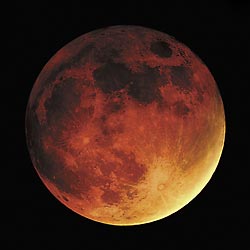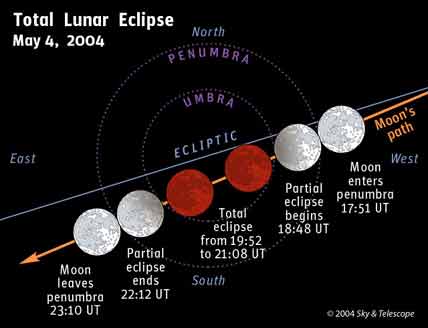
Much of Africa, Europe, and Asia will witness the entire lunar eclipse of May 4–5, 2004.
Sky & Telescope illustration.
On the evening of May 4, 2004, the full Moon cuts right through Earth’s shadow for skywatchers in Europe and Africa. In Asia and western Australia, the eclipse happens on the morning of the 5th. The diagram above shows the regions on Earth where the event may be seen, while the illustration below lists the Universal Times when successive stages of the eclipse begin and end. For observers in North America (who will miss out completely) or others who may be clouded out, the SAROS Group Scientific Expeditions plans to broadcast the eclipse, via live Web cam, from the Canary Islands.

This view of the totally eclipsed Moon (January 20–21, 2000) was obtained by Tennessee amateur Daryl Powell of Chattanooga. During this particular eclipse the Moon's northern (upper) limb passed deep into Earth's umbral shadow and thus appeared darker during totality. Similar geometry during the May 2004 eclipse may result in a similar-looking eclipse.
During this eclipse the Moon goes fairly deep within the southern part of Earth’s shadow core, called the umbra. Before and after this total phase, the Moon is partially eclipsed by the umbra’s edge. Earlier and later still are the much less noticeable stages when the Moon is in the shadow’s light outer fringe, or penumbra. Technically the Moon starts to enter the penumbra at 17:51 UT, but skywatchers won’t detect any hint of shading until about a half hour later.
Most dramatic is the total phase, when the Moon should take on a dull or perhaps fiery coppery hue. But even during totality the Moon is usually brighter than most stars. Last November 8–9, for example, a team of Brazilian observers led by Helio C. Vital found that the Moon never faded below magnitude –3.3 ± 0.2, or a little dimmer than Venus. Six months earlier, during the eclipse of May 15–16, 2003, the same group gauged the Moon to be only magnitude –2.1 (one-third as bright). On rare occasions, as during the eclipses of 1642 and 1816, the Moon has disappeared completely.
May offers a variety of comparisons for judging the eclipsed Moon’s magnitude: Venus at magnitude –4.5, Jupiter at –2.2, Arcturus at 0.0, and Spica and Antares at +1.0.

The path of the Moon through the Earth's shadow during the evening of May 4, 2004 (Universal Time).
Sky & Telescope illustration.
 0
0
Comments
You must be logged in to post a comment.